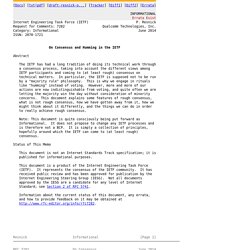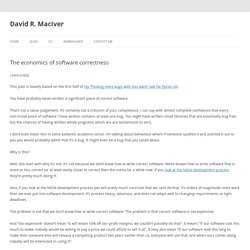

RFC 7282 - On Consensus and Humming in the IETF. [Docs] [txt|pdf] [draft-resnick-o...]

[Tracker] [Diff1] [Diff2] [Errata] INFORMATIONAL Errata Exist Internet Engineering Task Force (IETF) P. Resnick Request for Comments: 7282 Qualcomm Technologies, Inc. Category: Informational June 2014 ISSN: 2070-1721 Abstract The IETF has had a long tradition of doing its technical work through a consensus process, taking into account the different views among IETF participants and coming to (at least rough) consensus on technical matters.
In particular, the IETF is supposed not to be run by a "majority rule" philosophy. RFC 7282 On Consensus June 2014 Copyright Notice Copyright (c) 2014 IETF Trust and the persons identified as the document authors. RFC 7282 On Consensus June 2014 1. [Internal Memo] Principles for Decision-Making in a Flat Organization. This article started out as an internal conversation on a thread around how our team could learn to ask and give feedback more mindfully. It explores how we can balance making decisions quickly while maintaining our openness to feedback to ensure our decisions are good ones. At Doist we believe that open and sincere communication improves our decision-making process. That’s why we’ve built a culture that encourages feedback at all levels of decision-making: from purely technical solutions to team and product management.
We built our team communication app, Twist, around public threads to make that level of transparency and engagement possible for both ourselves and other remote workplaces. Initially, we thought that the more input you get, the better your decisions will be. 5 Red Flags Signaling Your Rebuild Will Fail - PKC Security. Les microservices : est-ce réaliste ? Les géants américains du Web ne jurent plus que par elle.

L'architecture en microservices balaye la SOA. Mais est-elle applicable partout, à toutes les applications ? Quels sont ses atouts, ses inconvénients ? Des experts répondent. Il est des architectures informatiques comme de l’habillement : une mode chasse la précédente. C’est, pour les fervents militants de cette nouvelle architecture, le seul moyen d’encaisser les montées en charge vertigineuses qu’un service Internet ou mobile peut connaitre lorsqu’il rencontre le succès à l'échelle mondiale. Puissante mais complexe, l’architecture en microservices demande de maitriser des solutions nouvelles sur lesquelles les compétences de haut niveau sont rares. Docker/dockercraft. How did Linkedin decrease code lines from 60K (Ruby) to 2K (Node.js)? They Write the Right Stuff. The right stuff kicks in at T-minus 31 seconds.

As the 120-ton space shuttle sits surrounded by almost 4 million pounds of rocket fuel, exhaling noxious fumes, visibly impatient to defy gravity, its on-board computers take command. Four identical machines, running identical software, pull information from thousands of sensors, make hundreds of milli-second decisions, vote on every decision, check with each other 250 times a second. A fifth computer, with different software, stands by to take control should the other four malfunction. At T-minus 6.6 seconds, if the pressures, pumps, and temperatures are nominal, the computers give the order to light the shuttle main engines — each of the three engines firing off precisely 160 milliseconds apart, tons of super-cooled liquid fuel pouring into combustion chambers, the ship rocking on its launch pad, held to the ground only by bolts.
As the main engines come to one million pounds of thrust, their exhausts tighten into blue diamonds of flame. The economics of software correctness. This post is loosely based on the first half of my “Finding more bugs with less work” talk for PyCon UK.

You have probably never written a significant piece of correct software. That’s not a value judgement. It’s certainly not a criticism of your competence. I can say with almost complete confidence that every non-trivial piece of software I have written contains at least one bug. You might have written small libraries that are essentially bug free, but the chances of having written whole programs which are are tantamount to zero. How we ended up with microservices. Microservices are a thing these days.

When I was at SoundCloud, I was responsible for the migration from a monolithic Ruby on Rails application to a constellation of microservices. I’ve told the technical side of this story multiple times, both in presentations, and as a multi-part series for SoundCloud’s engineering blog. These engineering bits are what people are most interested in hearing about, but recently I realised I never explained to a wider audience how we ended up using microservices to begin with. I am sorry to disappoint my fellow techies, but the reason we migrated to microservices had to do much more with productivity than pure technical matters.
I’ll explain. Note: This post definitely has a lot of revisionism, and, in trying to make it easier to understand, oversimplifies a fairly chaotic chain of events into a linear timeline. The Next project When I first joined the company, the most important project we had at play was what we internally called v2. Agile Games Nantes. La cathédrale et le bazar.